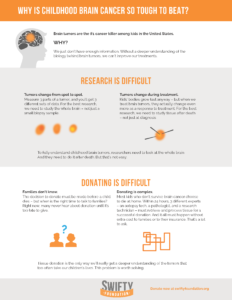Why is childhood brain cancer so tough to beat? Children are growing and changing and thus, so are their tumors. In addition, tumors can be different from one spot to another, and they’re different after treatment than they were at diagnosis. So, when a child dies of cancer, it may not even be the same type of cancer the child had at diagnosis.
So how do you treat a tumor that keeps changing?
We need more information. The more researchers understand and model the changing biology behind childhood brain tumors, the more doctors will be able to create effective treatment plans.
We must also get better at collecting tissue samples and learning from them.
To understand children’s brain cancer better, researchers need to study a child’s tumor at diagnosis, recurrence – and if necessary, after death. Only then will we understand why our treatments work for some children and not others.
Collecting the tissue needed to advance research faces the following challenges:
- Families typically are not invited to donate their child’s post-mortem tissue. Studies have shown that 90% of families would consent to tissue donation if asked. Perhaps the conversation is too difficult or health professionals are unaware of its value, but families deserve an opportunity to choose for themselves.
- Logistics have been a barrier to donation. It’s best if families consent prior to death which can be difficult to attain. In addition, 24 to 36 hours after death three different experts (an autopsy tech, a pathologist and a research technician – possibly in different states) must retrieve and process the tissue for a successful donation. This must all happen without extra cost to families.
- Post-mortem tissue collection and processing is not standardized. Not having standard protocols across institutions bogs down researchers and slows progress.
- Researchers are not able to make the most of donated tissue. Even after tissue is available for study, due to a lack of collaboration, the tissue and resulting findings are often not shared among competing cancer researchers.
To make real progress in treating pediatric brain cancer, we must make it easier for families to give tissue for research. And we must make it easier for researchers to share what they learn from the donated tissue.
The good news? With your help, we are making progress through our Post-Mortem Tissue Initiative, Gift from a Child.

